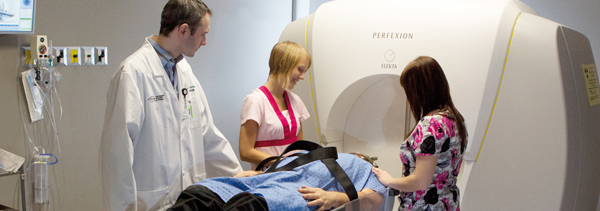Gamma Knife Radiosurgery Treatment

The CIUSSS de l’Estrie - CHUS is the only institution in Quebec to have a gamma knife.
Our team of specialists serves the entire province and eastern Canada. Gamma knife surgery is used to treat brain tumours and lésions by exposing them to highly focused radiation beams. This is a safe and effective method that is an alternative to traditionally invasive neurosurgery. Contrary to general radiotherapy, gamma knife radiosurgery requires only a single dose of radiation. Depending on the disease being treated and the number of tumours, the treatment itself may last anywhere from 10 minutes to 2 to 3 hours. Gamma knife treatment companion guideGamma knife advantages
- helps to cure or control the progression of the disease
- has few or no side effects
- does not require an incision contrary to traditional surgery
- involves neither general anesthesia nor convalescence
- is much faster than conventional surgery
- allows the patient to leave the hospital on the same day
- is comfortable, safe, and precise
Diseases treated (cancer and others)
- Brain metastases: most common malignant brain tumours from cancers from elsewhere in the body (lung, breast, etc.)
- Meningioma: usually benign tumour that develops on the meninges (the membranes that protect the inside of the skull) and can compress the brain.
- Vestibular schwannoma: benign tumour that develops from the insulating sheath of the nerves governing balance and hearing.
- Pituitary adenoma: benign tumour originating from a gland (pituitary gland) located at the base of the brain.
- Trigeminal neuralgia: facial pain felt along a branch of the trigeminal nerve (responsible for providing sensation to the face and for mastication).
- Arteriovenous malformation: persistent abnormal communication between arteries and veins in the brain at risk of bleeding.
- Tremor: movement disorder associated with Parkinson's disease, dystonia, and essential tremor.
- Obsessive-compulsive disorder: a psychiatric illness in which obsessions (e.g., contamination, safety, order) are satisfied by performing compulsive actions (e.g., repeated hand washing, checking a door is locked, and constantly repositioning objects).
Note | Our team of specialists serves the entire province and eastern Canada.. Ask your family physician or medical expert for a referral if you wish to have an assessment.
Other treatments
Share
